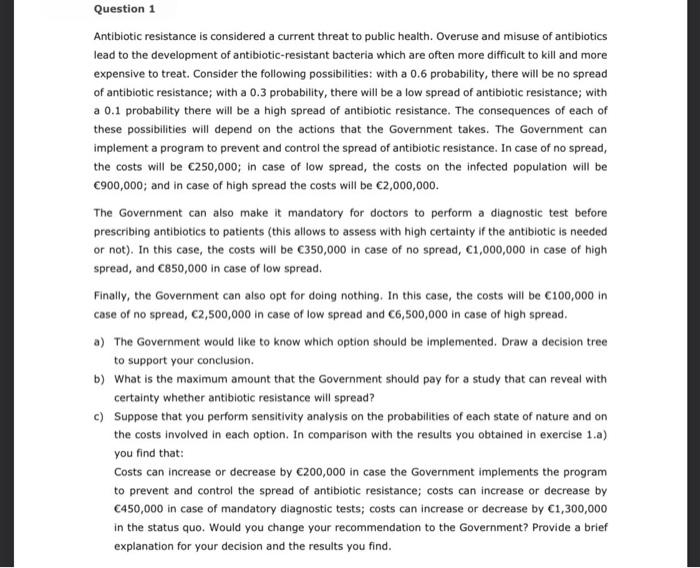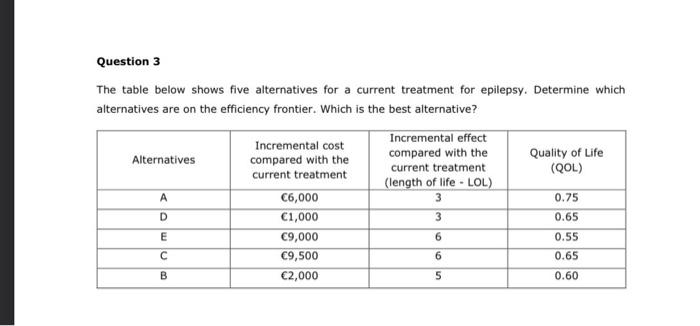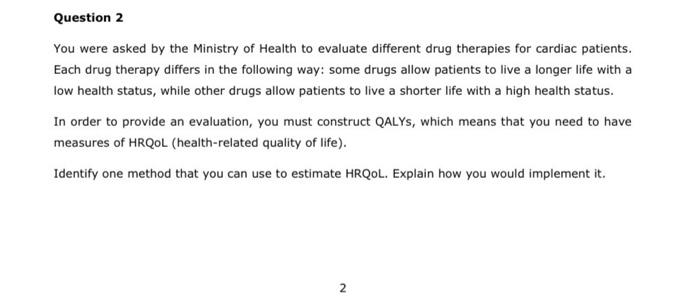Answered step by step
Verified Expert Solution
Question
1 Approved Answer
Question 1 Antibiotic resistance is considered a current threat to public health. Overuse and misuse of antibiotics lead to the development of antibiotic-resistant bacteria which


 Question 1 Antibiotic resistance is considered a current threat to public health. Overuse and misuse of antibiotics lead to the development of antibiotic-resistant bacteria which are often more difficult to kill and more expensive to treat. Consider the following possibilities: with a 0.6 probability, there will be no spread of antibiotic resistance; with a 0.3 probability, there will be a low spread of antibiotic resistance; with a 0.1 probability there will be a high spread of antibiotic resistance. The consequences of each of these possibilities will depend on the actions that the Government takes. The Government can implement a program to prevent and control the spread of antibiotic resistance. In case of no spread, the costs will be C250,000; in case of low spread, the costs on the infected population will be 900,000; and in case of high spread the costs will be C2,000,000. The Government can also make it mandatory for doctors to perform a diagnostic test before prescribing antibiotics to patients (this allows to assess with high certainty if the antibiotic is needed or not). In this case, the costs will be C350,000 in case of no spread, C1,000,000 in case of high spread, and 850,000 in case of low spread. Finally, the Government can also opt for doing nothing. In this case, the costs will be 100,000 in case of no spread, C2,500,000 in case of low spread and C6,500,000 in case of high spread. a) The Government would like to know which option should be implemented. Draw a decision tree to support your conclusion. b) What is the maximum amount that the Government should pay for a study that can reveal with certainty whether antibiotic resistance will spread? c) Suppose that you perform sensitivity analysis on the probabilities of each state of nature and on the costs involved in each option. In comparison with the results you obtained in exercise 1.a) you find that: Costs can increase or decrease by C200,000 in case the Government implements the program to prevent and control the spread of antibiotic resistance; costs can increase or decrease by 450,000 in case of mandatory diagnostic tests; costs can increase or decrease by C1,300,000 in the status quo. Would you change your recommendation to the Government? Provide a brief explanation for your decision and the results you find. Question 3 The table below shows five alternatives for a current treatment for epilepsy. Determine which alternatives are on the efficiency frontier. Which is the best alternative? Alternatives Incremental effect compared with the current treatment (length of life - LOL) 3 Quality of Life (QOL) A Incremental cost compared with the current treatment 6,000 1,000 9,000 9,500 2,000 0.75 0.65 D 3 E 6 6 0.55 0.65 0.60 B 5 Question 2 You were asked by the Ministry of Health to evaluate different drug therapies for cardiac patients. Each drug therapy differs in the following way: some drugs allow patients to live a longer life with a low health status, while other drugs allow patients to live a shorter life with a high health status. In order to provide an evaluation, you must construct QALYS, which means that you need to have measures of HRQOL (health-related quality of life). Identify one method that you can use to estimate HRQOL. Explain how you would implement it. 2 Question 1 Antibiotic resistance is considered a current threat to public health. Overuse and misuse of antibiotics lead to the development of antibiotic-resistant bacteria which are often more difficult to kill and more expensive to treat. Consider the following possibilities: with a 0.6 probability, there will be no spread of antibiotic resistance; with a 0.3 probability, there will be a low spread of antibiotic resistance; with a 0.1 probability there will be a high spread of antibiotic resistance. The consequences of each of these possibilities will depend on the actions that the Government takes. The Government can implement a program to prevent and control the spread of antibiotic resistance. In case of no spread, the costs will be C250,000; in case of low spread, the costs on the infected population will be 900,000; and in case of high spread the costs will be C2,000,000. The Government can also make it mandatory for doctors to perform a diagnostic test before prescribing antibiotics to patients (this allows to assess with high certainty if the antibiotic is needed or not). In this case, the costs will be C350,000 in case of no spread, C1,000,000 in case of high spread, and 850,000 in case of low spread. Finally, the Government can also opt for doing nothing. In this case, the costs will be 100,000 in case of no spread, C2,500,000 in case of low spread and C6,500,000 in case of high spread. a) The Government would like to know which option should be implemented. Draw a decision tree to support your conclusion. b) What is the maximum amount that the Government should pay for a study that can reveal with certainty whether antibiotic resistance will spread? c) Suppose that you perform sensitivity analysis on the probabilities of each state of nature and on the costs involved in each option. In comparison with the results you obtained in exercise 1.a) you find that: Costs can increase or decrease by C200,000 in case the Government implements the program to prevent and control the spread of antibiotic resistance; costs can increase or decrease by 450,000 in case of mandatory diagnostic tests; costs can increase or decrease by C1,300,000 in the status quo. Would you change your recommendation to the Government? Provide a brief explanation for your decision and the results you find. Question 3 The table below shows five alternatives for a current treatment for epilepsy. Determine which alternatives are on the efficiency frontier. Which is the best alternative? Alternatives Incremental effect compared with the current treatment (length of life - LOL) 3 Quality of Life (QOL) A Incremental cost compared with the current treatment 6,000 1,000 9,000 9,500 2,000 0.75 0.65 D 3 E 6 6 0.55 0.65 0.60 B 5 Question 2 You were asked by the Ministry of Health to evaluate different drug therapies for cardiac patients. Each drug therapy differs in the following way: some drugs allow patients to live a longer life with a low health status, while other drugs allow patients to live a shorter life with a high health status. In order to provide an evaluation, you must construct QALYS, which means that you need to have measures of HRQOL (health-related quality of life). Identify one method that you can use to estimate HRQOL. Explain how you would implement it. 2
Question 1 Antibiotic resistance is considered a current threat to public health. Overuse and misuse of antibiotics lead to the development of antibiotic-resistant bacteria which are often more difficult to kill and more expensive to treat. Consider the following possibilities: with a 0.6 probability, there will be no spread of antibiotic resistance; with a 0.3 probability, there will be a low spread of antibiotic resistance; with a 0.1 probability there will be a high spread of antibiotic resistance. The consequences of each of these possibilities will depend on the actions that the Government takes. The Government can implement a program to prevent and control the spread of antibiotic resistance. In case of no spread, the costs will be C250,000; in case of low spread, the costs on the infected population will be 900,000; and in case of high spread the costs will be C2,000,000. The Government can also make it mandatory for doctors to perform a diagnostic test before prescribing antibiotics to patients (this allows to assess with high certainty if the antibiotic is needed or not). In this case, the costs will be C350,000 in case of no spread, C1,000,000 in case of high spread, and 850,000 in case of low spread. Finally, the Government can also opt for doing nothing. In this case, the costs will be 100,000 in case of no spread, C2,500,000 in case of low spread and C6,500,000 in case of high spread. a) The Government would like to know which option should be implemented. Draw a decision tree to support your conclusion. b) What is the maximum amount that the Government should pay for a study that can reveal with certainty whether antibiotic resistance will spread? c) Suppose that you perform sensitivity analysis on the probabilities of each state of nature and on the costs involved in each option. In comparison with the results you obtained in exercise 1.a) you find that: Costs can increase or decrease by C200,000 in case the Government implements the program to prevent and control the spread of antibiotic resistance; costs can increase or decrease by 450,000 in case of mandatory diagnostic tests; costs can increase or decrease by C1,300,000 in the status quo. Would you change your recommendation to the Government? Provide a brief explanation for your decision and the results you find. Question 3 The table below shows five alternatives for a current treatment for epilepsy. Determine which alternatives are on the efficiency frontier. Which is the best alternative? Alternatives Incremental effect compared with the current treatment (length of life - LOL) 3 Quality of Life (QOL) A Incremental cost compared with the current treatment 6,000 1,000 9,000 9,500 2,000 0.75 0.65 D 3 E 6 6 0.55 0.65 0.60 B 5 Question 2 You were asked by the Ministry of Health to evaluate different drug therapies for cardiac patients. Each drug therapy differs in the following way: some drugs allow patients to live a longer life with a low health status, while other drugs allow patients to live a shorter life with a high health status. In order to provide an evaluation, you must construct QALYS, which means that you need to have measures of HRQOL (health-related quality of life). Identify one method that you can use to estimate HRQOL. Explain how you would implement it. 2 Question 1 Antibiotic resistance is considered a current threat to public health. Overuse and misuse of antibiotics lead to the development of antibiotic-resistant bacteria which are often more difficult to kill and more expensive to treat. Consider the following possibilities: with a 0.6 probability, there will be no spread of antibiotic resistance; with a 0.3 probability, there will be a low spread of antibiotic resistance; with a 0.1 probability there will be a high spread of antibiotic resistance. The consequences of each of these possibilities will depend on the actions that the Government takes. The Government can implement a program to prevent and control the spread of antibiotic resistance. In case of no spread, the costs will be C250,000; in case of low spread, the costs on the infected population will be 900,000; and in case of high spread the costs will be C2,000,000. The Government can also make it mandatory for doctors to perform a diagnostic test before prescribing antibiotics to patients (this allows to assess with high certainty if the antibiotic is needed or not). In this case, the costs will be C350,000 in case of no spread, C1,000,000 in case of high spread, and 850,000 in case of low spread. Finally, the Government can also opt for doing nothing. In this case, the costs will be 100,000 in case of no spread, C2,500,000 in case of low spread and C6,500,000 in case of high spread. a) The Government would like to know which option should be implemented. Draw a decision tree to support your conclusion. b) What is the maximum amount that the Government should pay for a study that can reveal with certainty whether antibiotic resistance will spread? c) Suppose that you perform sensitivity analysis on the probabilities of each state of nature and on the costs involved in each option. In comparison with the results you obtained in exercise 1.a) you find that: Costs can increase or decrease by C200,000 in case the Government implements the program to prevent and control the spread of antibiotic resistance; costs can increase or decrease by 450,000 in case of mandatory diagnostic tests; costs can increase or decrease by C1,300,000 in the status quo. Would you change your recommendation to the Government? Provide a brief explanation for your decision and the results you find. Question 3 The table below shows five alternatives for a current treatment for epilepsy. Determine which alternatives are on the efficiency frontier. Which is the best alternative? Alternatives Incremental effect compared with the current treatment (length of life - LOL) 3 Quality of Life (QOL) A Incremental cost compared with the current treatment 6,000 1,000 9,000 9,500 2,000 0.75 0.65 D 3 E 6 6 0.55 0.65 0.60 B 5 Question 2 You were asked by the Ministry of Health to evaluate different drug therapies for cardiac patients. Each drug therapy differs in the following way: some drugs allow patients to live a longer life with a low health status, while other drugs allow patients to live a shorter life with a high health status. In order to provide an evaluation, you must construct QALYS, which means that you need to have measures of HRQOL (health-related quality of life). Identify one method that you can use to estimate HRQOL. Explain how you would implement it. 2



Step by Step Solution
There are 3 Steps involved in it
Step: 1

Get Instant Access to Expert-Tailored Solutions
See step-by-step solutions with expert insights and AI powered tools for academic success
Step: 2

Step: 3

Ace Your Homework with AI
Get the answers you need in no time with our AI-driven, step-by-step assistance
Get Started


